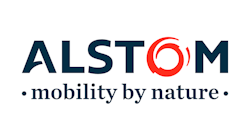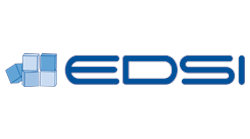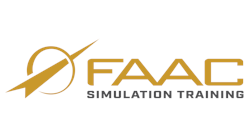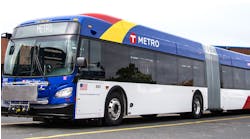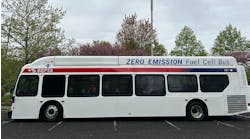Agencies and companies are adapting to meet the future workforce demands in public transportation.
Jacksonville, Fla.
Leigh Ann Rassler
Public Relations Manager
Jacksonville Transportation Authority
The Jacksonville Transportation Authority (JTA) took training to the next level by providing a bus simulator that creates vivid training environments for their 400 plus bus operators. It was unveiled in a ribbon cutting ceremony on March 24. The local media was on hand to experience first-hand what it is like to drive a 40 foot bus. The simulator provides new operators with additional practice before getting behind the wheel and refresher training for current operators.
The new high-tech MB-2000 bus-driving simulator, manufactured by FAAC Inc. is considered a world leader in simulator technologies. The simulator, which takes up an entire room in the transit operations building, provides a true 315 degree field of vision, driver cab replication and a motion seat allow students to feel when they hit a curb, turn too fast or brake too hard. Trainees learn what each knob and button does and how it will work in a real bus. Every aspect of the bus simulator is designed for the most true-to-life experience possible. This real-life approach to simulator development results in an effective and efficient training process with a host of benefits to both the trainer and trainee.
According to FAAC Inc., “transportation agencies have improved their safety performance by 64 percent for preventable accidents and increased the washout rate for new hire operators by 35 percent.” The training scenarios range from simple skill-building to muscle memory exercises. The key benefits include a reduction in collisions, reduction in on-board injuries, effective forward planning, mastery of mirror usage techniques, improved fuel economy and avoiding intersection conflicts
“We are pleased to bring this virtual environment to our bus operators,” said Lisa Darnall, Vice President of Transit Operations. “Not only is it an advantage for our trainees, but also for our veteran drivers. The simulator combines a high degree of realism with the ability to create various scenarios to enhance the knowledge and skills of our operators.”
The project was funded using Federal FTA Section 5307 Urbanized Area Formula funds. All operators are expected to utilize the simulator for new hire training, post-accident training and triennial recertification training.
The JTA welcomes other transit agencies to visit the site and experience the benefits of simulation.
Chicago, Ill.
Stephen Schlickman
Executive Director
Urban Transportation Center
The Urban Transportation Center at the University of Illinois at Chicago (UIC) aims to provide graduate student researchers with practical experience in real-world research projects that will better prepare them for transportation industry careers. Annually, some 20-30 students work with faculty and staff researchers on projects related to transportation planning, policy, operations, finance and management.
The UTC is also engaged in specific initiatives to help build the next generation of transportation professionals. Here are four projects – three underway, one proposed – that focus on workforce development.
IDOT/CUPPA Workforce Development
In 2014, the UTC and the College of Urban Planning and Public Affairs (CUPPA) entered into an agreement with the Illinois Department of Transportation (IDOT) on a workforce development initiative to train graduate students in areas that are critical to IDOT’s future workforce requirements.
There are two key elements to the program:
- Training students to conduct transportation research that’s relevant to IDOT.
- Employing students from CUPPA’s two academic programs as IDOT interns.
The workforce development program, which runs through first half of 2015, currently employs two graduate students on UTC research projects and two additional students who work as interns within IDOT’s Chicago office. The program will be renewed for 2015/16.
PTPM Certificate Program
For the past few years, I have been a co-instructor on a 12-credit, three course transit certificate program to best train our students to be transit agency administrators. Through the Public Transit & Planning Management program (PTPM), students learn about the various functions of a public transit system, how levels of management interact and the complicated context of a transit agency. They also learn ways to effectively communicate within transit agencies and how agencies are funded and financed.
NuRail Curriculum Development
As a partner in NuRail, a U.S. DOT Tier 1 university transportation center, the UTC supports the development of new courses that focus on U.S. rail research and operational needs. One long-range goal is to facilitate training and development of the future rail transportation and engineering workforce.
FTA Ladders of Opportunity
Earlier in 2015, the UTC submitted a proposal to convert its nationally-acclaimed transit management and planning curriculum to a cost-efficient e-learning system format and content optimized for smaller transit agencies. The proposal is now being reviewed by the Federal Transit Administration through its Ladders in Opportunity in Transit initiative.
This revised curriculum will be initially developed jointly by professors at UIC and the senior managers at three small Illinois transit agencies and focus on the unique professional skills the agencies need in their administrative workforce. The curriculum will be available through individual lectures, on-demand webinars and semester-length courses. Participants will enjoy flexible access to this advanced graduate curriculum. The goal is to eventually tailor the curriculum to fit the needs of small operators in other states as well.
Dearborn, Mich.
Kenneth Mall
Managing Director, Workforce Consulting
Educational Data Systems Inc.
The biggest future workforce challenge facing our organization is finding enough skilled professionals that will fit into our culture – not unlike many of our clients. From a demographic perspective EDSI has a relatively young workforce, so we haven’t experienced the affect of the greying of the workforce – even though plenty of us at EDSI have grey hair.
New entry level employees at EDSI are part of a defined on-boarding process that includes becoming familiar with the EDSI Way and our culture, training on specific job functions and related processes, and assignment to a mentor. Being a professional services firm working from an office environment we utilize a blended training platform – which means we combine classroom, web based, distance learning, and on-the-job training to provide learning opportunities to our employees. Leveraging technology to deliver training is important because our 500-plus employees are spread out across eight states.
Various training delivery technologies help to maximize the time employees spend in training and in some cases allows for self-paced training during downtime. Technology also helps us to be consistent in our training message by providing a platform to push out the same training across our network of offices. Not to be forgotten, our mentors are a critical part of the training process. Mentors are available to assist with the development of new hire’s job specific skills and help new hires understand and navigate our organization and our culture.
The mentoring program also provides new employees with an experienced staff person, other than their supervisor, whom they can go to seek job advice; suggestions on working within our culture; and future career growth opportunities – which helps employees focus more on their performance and less on non-value added activities.
Future challenges facing our transit industry clients include rapidly advancing technology combined with the impending retirements of experienced employees. Within transit agencies the jobs most affected by technology and retirements are the frontline line maintenance positons – rail car maintainers, bus technicians, facilities maintainers, and other infrastructure maintenance people.
Just in the past 10 years the technology driving the transit industry has evolved significantly. For example, one of our clients, the Metropolitan Atlanta Rapid Transit Authority (MARTA) has utilized essentially the same train control system since they began operations more than 30 years and most of their train control technicians have only worked on that system. MARTA is half way through completing a major upgrade of the system, which skips generations of technology. Once complete it will be one of the most advanced train control systems in the county, which will require upgrading the technology skills of current workers.
To aid in training current and new technicians, Alstom Signaling Inc. is providing a simulated training environment in a classroom at MARTA that includes actual Train Control Field Units, the industrial controls system used in the field. The classroom training curriculum includes a significant amount of hands on training – both in the classroom and in the field. As the upgraded train control system is brought on line, many of MARTA’s experienced technicians are expected to retire.
This will be both bad and good. The good part is that MARTA will have an opportunity to hire new technicians that are more familiar with newer industrial control systems technology. The bad part is that many of these new technicians will not have the railroad maintenance experience of MARTA’s current team – the new technicians will be technically savvy, but lack operational experience. The training curriculum under development will address this realization. MARTA has been proactive at identifying their needs and working with their contractors to address them.
New Brunswick, N.J.
Paul Larrousse
Director
National Transit Institute
The face of our industry has been changing rapidly and so has the challenge of having a qualified and trained workforce.
There are many programs that exist to address the training needs of our industry. In addition to programs at NTI, there are programs at TSI, the Transportation Learning Center, APTA, CTAA, and Eno just to name a few. All of us who are involved in training have been partnering to make sure that we do not duplicate efforts and that we provide the broadest range of training possible to address our industry’s many needs.
To reach the workforce with training, our primary method is still the traditional classroom format. This is still proven to be the best method for adults to learn. It provides for interaction with one’s peers and develops networks to support efforts when the trainee returns home.
We have also adapted our training to move beyond the traditional classroom model. In the case of our technology training, we have moved from the classroom course model. Technology is changing so rapidly that by the time we complete a course it is outdated. Instead we have changed our format to seminar/workshop that focuses on a specific technology or application of technology. This allows us to be timely and adapt as we move to the next offering.
We have also explored and used the new technologies that are available to provide distance learning. Webinars have proven very popular and successful to reach a broad audience on a specific topic without having to leave home. NTI has offered a few on-line courses and we recently held our first course via video conferencing when we connected our offices in NJ to the The Bus in Honolulu, Hawaii.
What we have learned is that training is not a one- size- fits- all product. We have to be able to adapt the various learning methods and styles of our customers. This requires us to try new methods of delivering training while not dismissing what has proven to be tried and true. The bottom line is to be flexible and responsive to our customer’s needs.
The biggest issue that we face in providing training is the limited resources. There are so many needs and demands that we simply do not have the resources to address them all. There are re-authorization proposals to provide additional resources, but this still may not be enough to address all of the needs. The pressure will come from the baby boomers retiring and our need to train up a vast number of replacements.
We can only expect the need for training in our industry to increase. With a changing environment in which with operate and an aging workforce, training is not something that is going to go away. We will have to be responsive and adaptive to meet all of the demands to insure that transit thrives in our communities in the future.
Fargo, N.D.
Jill Hough
Program Director
Small Urban and Rural Transit Center
Upper Great Plains Transportation Institute
North Dakota State University
At SURTC, we engage in workforce development in our research, education, and training. We recognize it is imperative to attract young talent to public transportation and to retain as much of the current workforce as possible. Qualifications are earned and validated through an educational process, through both academic and non-academic training. Our education and training programs directly impact current workforce needs. We address future workforce challenges by helping transit agencies identify their needs and then find and apply solutions such as new courses or the addition or modification of material in existing courses, both in the academic setting and in the training arena.
At North Dakota State University, we offer degrees in transportation that include public transportation courses. We recently launched the transit track of the Transportation Leadership Graduate Certificate (TLGC), a program that helps working professionals improve their skills in public transportation. The TLGC includes courses from universities across the United States, with NDSU contributing two courses in transit.
The first class, designed by transit professionals, provides an overview of seven core transit areas. Students are assigned an industry mentor to work with throughout the class. The on-line course has attracted students and professionals from all over the globe including Spain, Texas, Washington, DC, New York, and Massachusetts.
The second course provides more depth in areas critical to transit, including modeling. The TLGC requires students also enroll in the “Ethics, Leadership, and Academic Conduct.” Students learn how to best handle situations that pose ethical dilemmas and conduct themselves in an ethical manner. The program also fosters students’ leadership skills, filling a training void for professionals promoted to leadership positions but who have not had the proper training or may not know how to gain essential leadership skills.
Our training and outreach program has a robust set of training topics to help the current workforce develop their skills. To keep the topics fresh and applicable and to best meet the needs of transit agencies, we periodically survey agencies and associations. In February and March, our trainer, Rob Lynch, sent a survey to transit agencies and associations across the United States. Results revealed a desire for more training in front-line customer service, driver skills, coordination, and civil rights. We already offer training on some of these topics, but we will update the content to assure our training meets current needs. By the request of the agencies we serve, our three-day trainings have been condensed into two days to provide the most important information in the most efficient manner while reducing the number of days transit employees are out of the office. Employees who take our Transit I: The Foundations course and Transit II: The Pillars are eligible to earn an Advanced Transit Professional certificate administered through North Dakota State University.
Albany, N.Y.
Kelli Schreivogl
Director of Human Resources
Capital District Transportation Authority
Do more with less. Transit properties, including CDTA, hear this on a regular basis as we contend with flat funding, unfunded mandates and rising expenses. Without a crystal ball, we can only speculate how our industry will look in five to ten years, but it is our job as Managers to best prepare our staff for the road ahead.
On the transportation front, we rely more and more on technology. It is used to create leaner, more productive schedules for drivers, to track inefficiencies that are happening within the system and to give more useful information to our customers. As technology changes and becomes more complex, it has been a challenge for us to keep our drivers trained on these new additions, as well as to keep them informed of the many changes going on each and every day. We have been forced to learn how to communicate and train our workforce in very unconventional ways, given the fast pace, logistical issues and crazy schedules that many of them work. We are heavily relying on technology to help us to train and to communicate, one tool would be a new online training system that can be accessed by employees via the web. Employees can log in while on a break or after their shift to take courses such as Refresher/Safety Training for drivers or Diversity training for all staff. They can also choose to do this while in the privacy of their own home or even on their smart phone. We need to make sure that our staff is always one step ahead of our customers so that they are equipped to provide the best possible customer service.
In maintenance, the biggest hurdle is keeping up with technological advances and encouraging staff to embrace it, even those employees who have been with us for decades and who may be adverse to change. We are focused on training our maintenance staff to use technology that will make them more self-sufficient. An example of this was making sure that 2nd and 3rd shift employees had access to parts needed to perform repairs when the stock room was closed. Historically Foreman were tasked with retrieving these parts, but there was a lack of inventory control. We have now trained employees to use a self-serve vending machine so that 24x7 they can get the most widely used parts by simply swiping their employee badge and making a choice. This machine also logs all parts that are dispensed so that inventory is updated immediately. We have also introduced an ASE certification study program where staff can use in house materials to study for exams which can qualify them for an incentive pay level.
It is important to CDTA that our training approach remains focused but two pronged. Fifty percent needs to be CDTA leading the way and introducing training to move staff forward, but the other fifty percent needs to be the employee taking the initiative and embracing the learning process as more of a benefit than a burden.
Mississauga, Ontario
Paul Carey
Product Manager - Technology Solutions
Bombardier Transportation – Americas Division
Training any large multi-disciplinary global transit workforce is no easy task. Battling the opposing forces of ever increasing demands with ever shrinking resources can make delivering quality training seem impossible. Throw in different labor agreements or regulatory requirements, and now you’ve got a real challenge.
Having struggled with these same issues, Bombardier applied technological innovation to managing our training delivery and record management, with tremendous success.
At our GO Transit operations and maintenance site in Toronto, we implemented a new company-wide learning system to standardize employee training delivery, maintain employee training records and manage recertification. Available 24/7, the system automatically generates reminders for compliance retraining (e.g. bi-annual recertification for hostlers). The system generates reports about training for specific locations, courses, or even down to a specific employee’s training requirements and history. No more filing through cabinets full of paper documents - auditing training data is merely clicks away.
The traditional classroom poses its own challenges. How do you certify thousands of employees annually? How far must employees be expected to travel to attend? What happens when you have more employees than seats in the classroom? Scheduling in-person training is complicated and frustrating. And training a mixed class of new hires with seasoned employees risks a pace that accommodates new students but bores the seasoned hires, or overwhelms the new employees but satisfies students who have heard the content (many times) before. Our technology-based system delivers consistent content at the pace of each individual. Courses can be taken before work, during lunch, after work, or even at home. Instead of sleeping in the back of the classroom, students are engaged by the media-rich, interactive content of the course. Knowledge checks throughout the course ensures the learner absorbs key concepts. Many knowledge checks are in the form of interactivities and games to keep the content less intimidating and more enjoyable. Employees who enjoy the content are much more likely to remember the content. And isn’t that the point of training?
After creating digitized training material, why not re-use pieces of that content to support your workforce on the shop floor? Bombardier integrated its asset management software with an Automated Vehicle Inspection System. AVIS scans and assesses rolling stock, generates service requests and dispatches mobile work orders to technicians with supporting information. Support information includes short “how to” videos, schematic diagrams, component part numbers, photos and specs. Users can add helpful tips and comments for completing inspections and tasks which are accessible to others performing the same task. This knowledge-sharing supports a culture of continuous improvement that accelerates a new employee’s onboarding process, and retains the knowledge base of long time employees who are approaching retirement. Upon work order completion, the system updates automatically.

